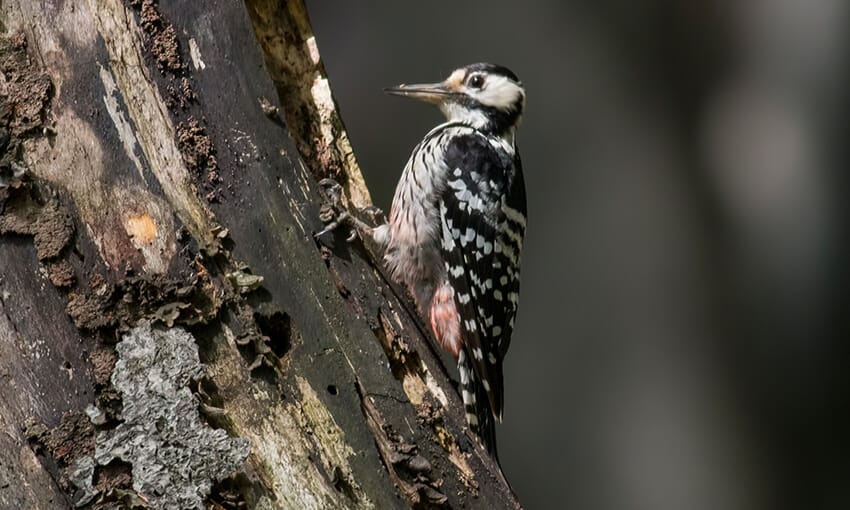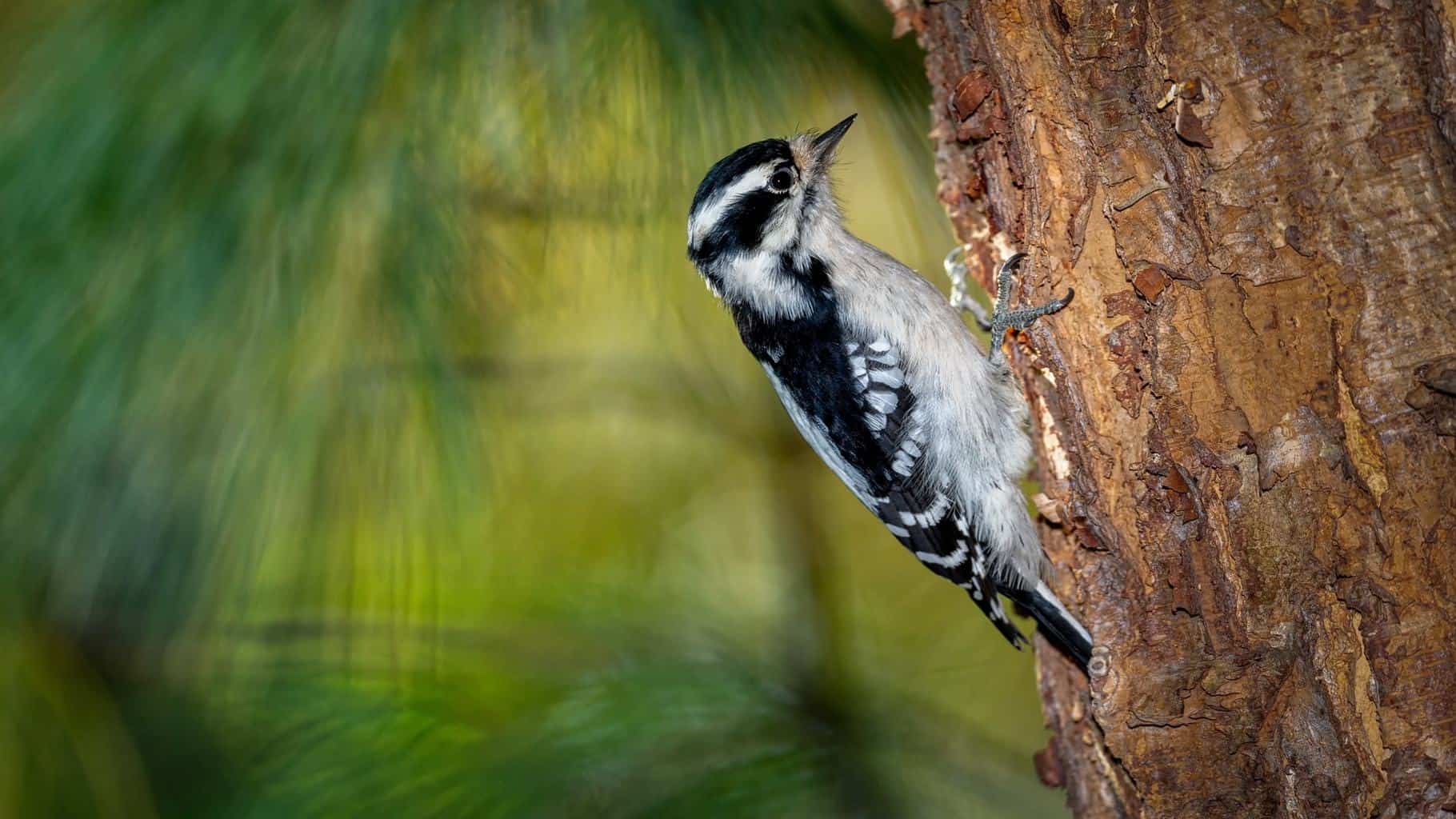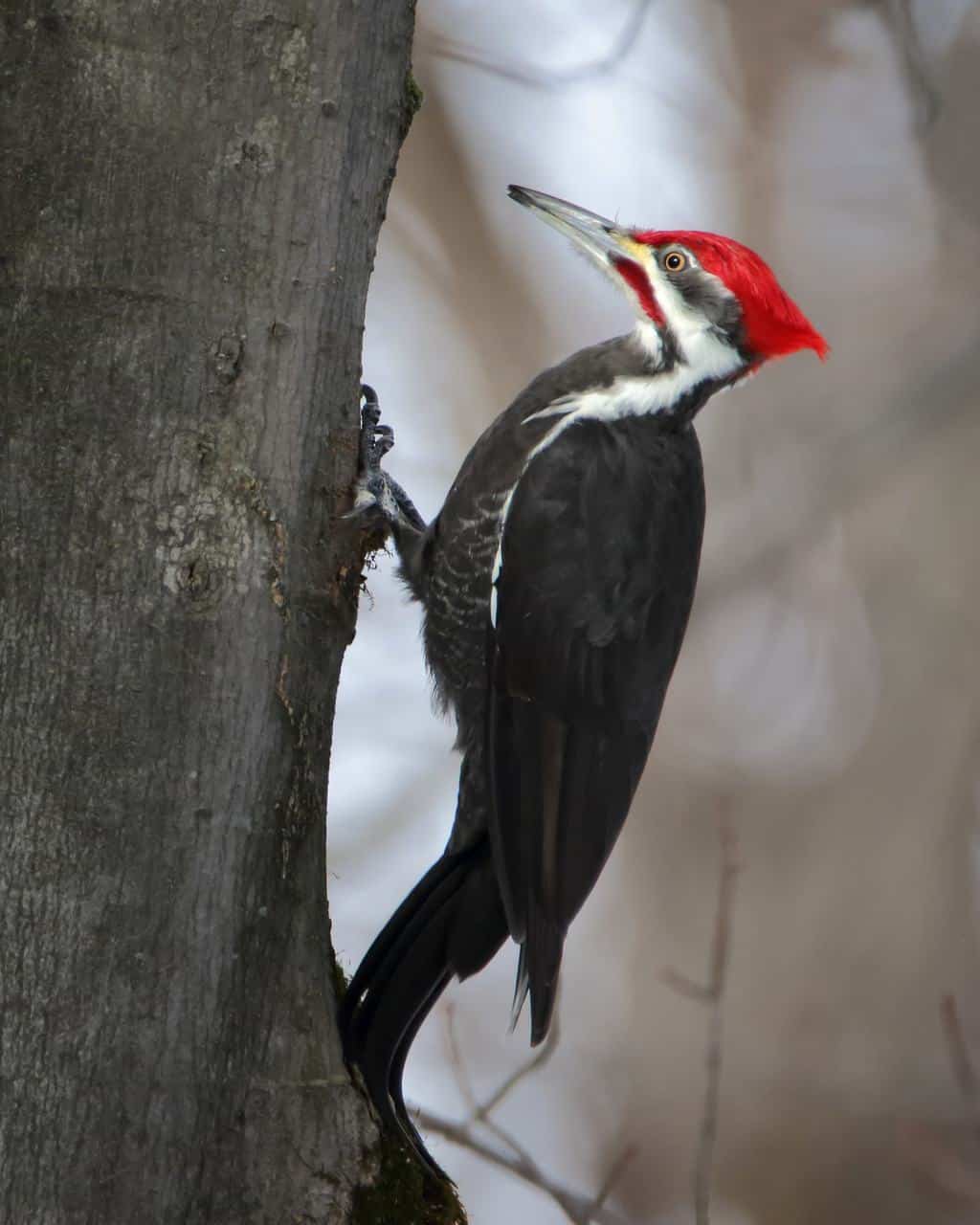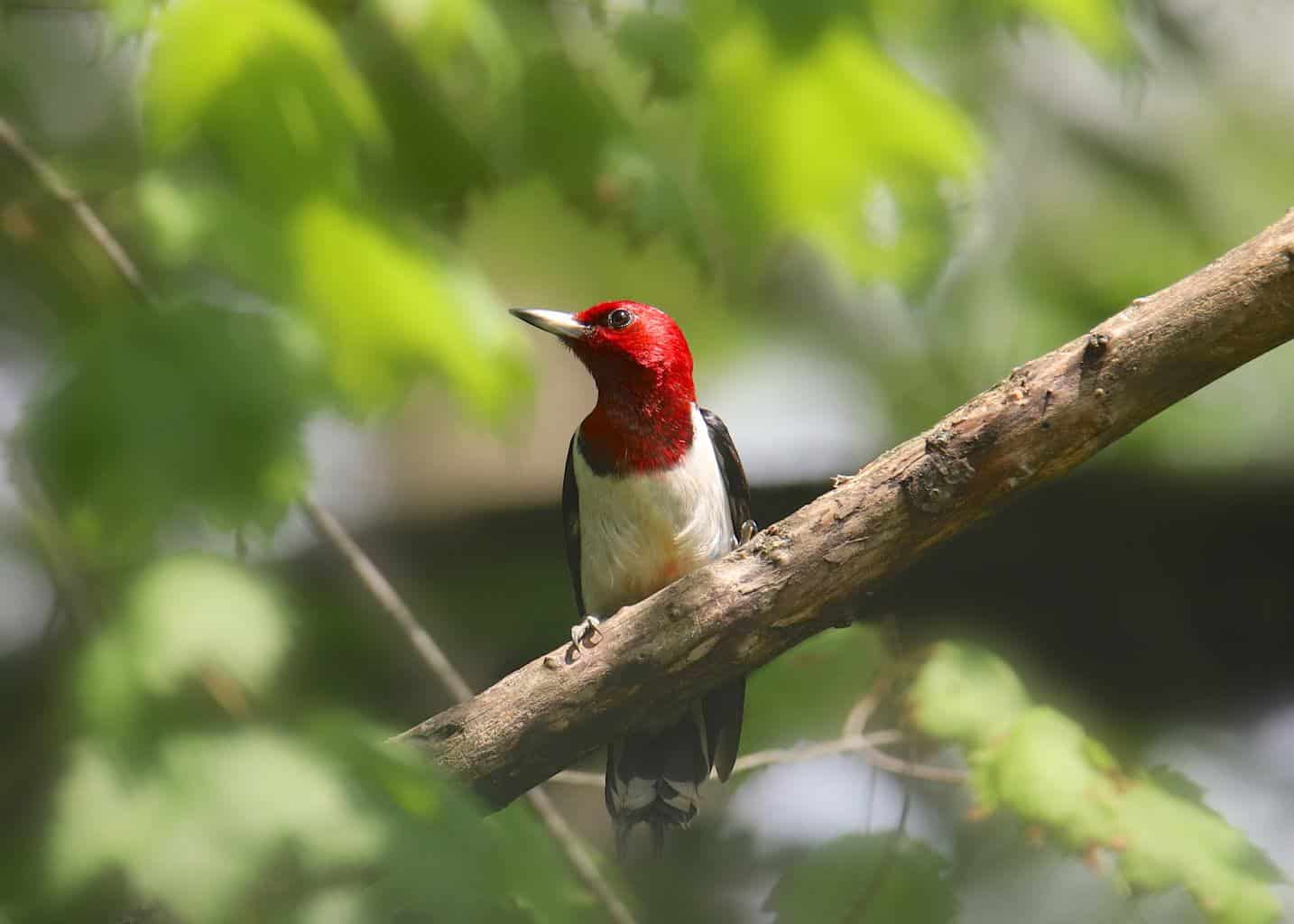The woods by my house are home to several varieties of woodpeckers, but I hear them far more often than I see them.
Woodpeckers vary wildly in appearance, size, shape, and coloring. That said, it probably is one if you see a bird reminiscent of a woodpecker!
Sometimes, you might spot a sapsucker or flicker, but these are actually just members of the woodpecker family with a different name.
Knowing what to look for when you hear the knock-knock-knock of a woodpecker on a tree means knowing what kinds of woodpeckers live in your region and what look-alikes you might encounter!
What Makes a Woodpecker a Woodpecker?
Some bird families share a specific physical trait or group of traits. For example, all Corvids are stocky, noisy birds with thick legs. All hummingbirds are short-bodied with long weeks and a thin, long bill.
All woodpeckers share a behavior: pecking at tree branches and tree trunks. They do this for two reasons:
- To communicate with one another
- To access insects that make up a large part of their diet
They may also eat other things, like fruit, eggs, table scraps, tree sap, carcasses, and even small animals, but their central shared trait is using their strong, sharp bill to seek out
Woodpeckers belong to the family Picidae. Another Picidae is piculets, sapsuckers, and wrynecks. The Pileated Woodpecker is the largest woodpecker in the world, clocking in at nearly 19″. The smallest is the Downy Woodpecker, which is usually between 5.5-6.5″ in length.
Where Do Woodpeckers Live?
Woodpeckers can be found across most of the globe, but they are not found at either of the poles, nor in Australia, New Guinea, New Zealand, or Madagascar.
Most woodpeckers are forest dwellers, although some live in less common habitats. The Gila Woodpecker, for example, lives in the desert and pecks on cacti instead of trees.
The International Ornithological Committee (IOC) recognizes a whopping 239 kinds of woodpeckers around the world! Of those, only 23 can be found in North America.
Woodpeckers in the USA
These are the woodpeckers that live for at least part of the year in the US. Some species are endangered, with only 5000 individuals in the world. Others number in the millions!
- Acorn Woodpecker (2 million)
- American Three-toed Woodpecker (1.4 million)
- Arizona Woodpecker (less than 5000)
- Black-backed Woodpecker (1.8 million)
- Downy Woodpecker (13 million)
- Gila Woodpecker (430,000)
- Gilded Flicker (240,000)
- Golden-fronted Woodpecker (820,000)
- Hairy Woodpecker (8.5 million)
- Ivory-billed Woodpecker (likely extinct)
- Ladder-backed Woodpecker (2.1 million)
- Lewis’s Woodpecker (69,000)
- Northern Flicker (9.9 million)
- Nutall’s Woodpecker (650,000)
- Pileated Woodpecker (2.6 million)
- Red-belled Woodpecker (15 million)
- Red-breasted Sapsucker (2.3 million)
- Red-cockaded Woodpecker (15,000)
- Red-headed Woodpecker (1.6 million)
- Red-naped Sapsucker (2 million)
- White-headed Woodpecker (200,000)
- Williamson’s Sapsucker (290,000)
- Yellow-bellied Woodpecker (12 million)
Notice that there are also sapsuckers and flickers listed there, too? That’s because flickers and sapsuckers are categorized as woodpeckers alongside traditionally named woodpeckers.
What Is the Difference Between a Sapsucker and a Woodpecker?
Sapsuckers are part of the woodpecker family, but their reason for pecking at tree limbs and trunks differs from that of their woodpecker cousins.
Like the name implies, Sapsuckers live off a diet dependent upon tree sap. They make holes by hammering and pecking at trees, but they do so to gain access to the tree sap, not to get insects. That said, sapsuckers also eat insects as part of their diet.
Are There Other Birds That Look Like Woodpeckers?
Most birds that look like woodpeckers are, in fact, woodpeckers. However, there are other birds that share one or two important traits with different kinds of woodpeckers.
For example, the Red-headed Woodpecker and the Pileated Woodpecker both have red heads, and so does a Scarlet-Headed Blackbird. Birders are unlikely to mix up these three birds, but it is cool to notice the similarities!
Some woodpeckers have crests on their heads, just like the Pyrrhuloxia and the Steller’s Jay. The Belted Kingfisher has a dagger-like bill, similar to a woodpecker’s sharp, thick bill.
Let’s take a look at some of the different kinds of woodpeckers to learn just how much variety there can be from one woodpecker species to the next.
Then we’ll compare some birds totally unrelated to woodpeckers to see what traits they might share with our noisy, drumming bird friends!
10 Types of Woodpeckers
Let’s start with 10 interesting woodpecker species, including flickers and sapsuckers!
Acorn Woodpecker

Acorn Woodpeckers live in large groups. They can be found in oak forests, where they collect thousands of acorns every year and store them in the holes they’ve burrowed into trees with their strong bills. They can store up to 50,000 acorns in a single oak tree!
Acorn Woodpeckers also have an interesting communication strategy. There is always at least one Acord Woodpecker on duty, watching to ensure no other birds, squirrels, or animals come to steal their acorns.
The Acorn Woodpecker is increasing in population, but they are susceptible to habitat loss and invasive bird species like European Starlings. In the US, they live in Washington, Oregon, California, and throughout the southwest.
They also inhabit the western half of Mexico and into Central and South America.
These little birds are mostly black, but they have red caps on their heads, off-white faces, and a black bill with a black rings around them.
Black-Backed Woodpecker

The Black-backed Woodpecker is hard to spot among the trees, and your best bet may be to look for them in the aftermath of a forest fire. They also like areas with lots of dead trees.
The Black-backed Woodpecker and the American Three-toed Woodpecker are the only birds flaking the bark off trees as they’re looking for food.
As you can probably guess, the back of a Black-backed Woodpecker is pretty much all black. There are a few white places on the flight feathers. The flanks are barred, and their face has a little white mustache.
The only difference between males and females is that males have a little yellow spot on the very top of their heads.
These woodpeckers live most in Canada, with a range that stretches across the entire country. They also find their way to the northern United States.
Downy Woodpecker

The Downy Woodpecker is the smallest woodpecker in the world. Aside from the southern border, these little black and white birds can be found throughout the US and most of Canada.
They have a small, straight bill and a black and white checkered pattern on their wings. They have a thick white stripe down the center of their back, and the stripes on their head are equally dramatic. Males have a flash of red on their heads, whereas females don’t.
Downy Woodpeckers are difficult to differentiate from Hairy Woodpeckers, especially because these two birds inhabit the same territories.
Gila Woodpecker

The Gila Woodpecker stands out from the others on this list because it doesn’t live in the forests, and it doesn’t peck at trees.
Instead, the Gila Woodpecker lives in arid forests and gets its food from cacti! They eat bugs, small vertebrate animals, and wild berries.
This woodpecker will create a hole in a saguaro cactus and then leave the hole alone for a few months. The cactus will dry out inside, creating solid “walls” within the cavity.
Their bodies are gray-brown but have vibrant black and white bars on their wings. Males have a small red patch right in the center of their forehead.
Gilded Flicker

This is another desert woodpecker. The Gilded Flicker is light brown and gray. It has a black crescent shape pointing down from its chest, and its wings are barred. Most of its head is gray, but the top of the head is pinkish brown.
Gilded Flickers rarely nest in trees, choosing instead to nest in cactuses as Gila Woodpeckers do. They are ground foragers who use their long tongues to slurp ants out of their nests.
They are only found in the Sonoran Desert in southern California, Arizona, and Mexico.
Hairy Woodpecker

Despite being quite small, Hairy Woodpeckers are strong birds with a big impact on their environment. Their territory spreads throughout the entire United States, most of Canada, and a narrow strip of central Mexico.
The biggest difference between a Hairy Woodpecker and a Downy Woodpecker is that the Hairy Woodpecker’s bill is much longer.
They can damage mature and immature trees significantly, although they sometimes like to explore the holes left behind by the much larger Pileated Woodpecker.
Northern Flicker

The Northern Flicker is larger than the Gilded Flicker. It is widespread across the US all year round but also finds its way into Canada for the breeding season. They are one of the only truly migratory woodpeckers.
Northern Flickers have scalloped feathers, which means that the feathers are black, but they are outlined or edged in a different color. In the east part of the country, their wings are yellow, and in the west, they are red.
They nest in holes in trees, but they spend a lot of time on the ground because ants are their main dietary staple. Their tongue is long and barbed, which allows them to access ants.
Pileated Woodpecker

The Pileated Woodpecker is the world’s largest woodpecker species. It is nearly the size of a crow. In fact, when it flies, it looks a bit like a crow from a distance.
Pileated Woodpeckers are almost entirely black, except that they have a bright red crest and white stripes on the face. Males and females look about the same.
They are incredibly powerful birds, making large holes in dead and dying trees. Their main diet is carpenter ants, and they can destroy an entire tree by going after the ants that live in the bark!
When they are done with their holes, other animals move in, including other woodpeckers, owls, ducks, and bats.
These woodpeckers are only found in the eastern half of the United States, across most of Canada, and along a narrow strip of the Pacific Northwest.
Red-Breasted Sapsucker

The Red-breasted Sapsucker is such a pretty woodpecker!
Males and females have bright redheads and breasts. You’ll find a little white patch between the eye and the bill. The rest of the bird is a mottled black with some white patches.
Like the other sapsuckers in this article, the Red-breasted Sapsucker survives on a diet of tree sap. They access this tree sap by drilling shallow holes in the trees.
They prefer coniferous forests but will also live among deciduous trees and orchards. They migrate to lower elevation areas in the winter.
Red-headed Woodpecker

The Red-headed Woodpecker’s bright red head sits atop an all-white body and a pair of wings that are half white and half dark black.
They have two unique behavioral traits that are rare in woodpeckers. First, they’ll catch insects that are in mid-flight. Second, they will store their food.
Red-headed woodpeckers hide extra food wherever they can. They’ll stash seeds and insects under roof shingles, in the cracks of a wooden building, in fencepost holes, and under the bark of their preferred trees.
One disturbing detail is that they will put some insects into these spaces while still alive. Grasshoppers, for example, will be alive when they are stuffed into Red-headed Woodpecker storage–but they will be pushed so far into the crack that they cannot get loose.
Other Birds That Look Like Woodpeckers
There are no birds that have the same woodpecker-like appearance except for members of the woodpecker family.
However, some birds do have fascinating similarities to woodpeckers! Let’s look at the birds that share something in common with the woodpeckers I’ve listed so far!
Birds With Red Heads
Like the Red-headed Woodpecker and Pileated Woodpecker, there are several birds that have red heads.
- Red-headed Finch
- Pyrrhuloxia
- Red-crested Cardinal
- European Robin
- Crimson Hooded Manakin
Birds With a Red Stripe or Crown on Their Heads
Many woodpeckers- especially males- have a red stripe on their heads. Other birds share this same trait.
- Ruby-crowned Kinglet
- Blue Pitta
- Common Crane
Birds With Crests
The flashy cresh of the Pileated Woodpecker makes him stand out from the other birds in the forest. Woodpeckers are not the only crested birds!
- Steller’s Jay
- Crested Caracara
- Oak Titmouse
- Hoopoes
- Crested Partridge
- Frilled Coquette
Birds the Same Size as a Pileated Woodpecker
Pileated Woodpeckers are large woodpeckers, but that doesn’t make them the only large birds in the forest and plains.
Bird species that are about the same size as the Pileated Woodpecker include:
- American Crow
- Cooper’s Hawk
- Great-Tailed Grackle
- Ravens

